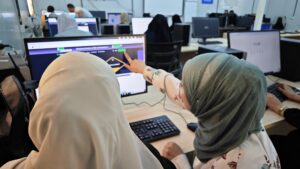In theory, resilience education is a long-term investment. In practice, it must also contend with the urgencies of survival.
For months, Phoenix Space has been working to implement our Resilience Academy program in Pakistan—designed to offer real-life-oriented STEM learning in contexts of displacement and crisis. But we’ve been stopped in our tracks, again and again, by a cascade of challenges that reveal a deeper truth:
Delivering education in a polycrisis world is no longer a matter of logistics. It is a test of system resilience, humility, and the power of local partnerships.
The Ground Beneath Us Is Always Moving
Pakistan today is a vivid case study of intersecting crises. In just the past few months, our local partners have faced:
- Escalating geopolitical conflict with India, leading to airspace closures and travel restrictions
- Extreme heat and widespread school shutdowns
- Acute water shortages that have brought daily life in rural communities to a halt
- Deepening poverty and a vast, underserved educational landscape—many schools operating on parent-funded resources, often with no external support
One of our partners wrote:
“Life is at a standstill in the villages. We are finding it difficult to move forward because problems are constantly cropping up.”
And yet, despite these conditions, grassroots innovation continues.
Locally made educational materials are being produced. Volunteers travel long distances to reach remote schools. The will is there. But the system—exposed to constant shock—requires more than will. It requires a new kind of support.
This Is the New Normal
What we are witnessing in Pakistan is not an exception. It is the emerging norm for humanitarian education.
Polycrisis environments—where conflict, climate, poverty, and political instability collide—are becoming the defining context for educational delivery. These conditions stretch timelines, exhaust capacities, and (when funding is involved) test donor patience. But they also invite a fundamental shift in how we understand success and sustainability.
What Must Change
At Phoenix Space, our work in Pakistan has deepened our belief that humanitarian education must be built from the ground up—with, not for, local communities. It has also made clear that the traditional models of aid and intervention are no longer adequate to the complexity we face.
Here’s what needs to change:
- Fund flexibility, not just outputs. Rigid timelines, KPIs, and pre-designed frameworks often collapse when faced with real-world complexity. True resilience work takes time—and that time should be seen as part of the impact, not a deviation from it.
- Redefine the role of funding. What if support was non-monetary, resilience building and could lead to communities no longer needing external support at all? Our partners in Pakistan operate under a zero charity model—empowering local communities to generate their own materials, build their own systems, and lead their own change. The result? Solutions that are low-cost, scalable, and genuinely sustainable.
- Fund resilience, not dependency. Too often, aid cycles create reliance on outside resources, experts, or visibility. But what if we invested in invisible resilience—local knowledge systems, peer-to-peer infrastructure, and village-scale ingenuity? What if the measure of success wasn’t how much we deliver, but how little they need from us a year from now?
This is not abstract idealism. It is happening now, on the ground, through grassroots leadership and intelligent resource use. What’s missing is the trust, time, and flexible funding needed to let it grow.
A Call to Partners
To our fellow collaborators, NGOs, funders, and humanitarian actors: if we want education to truly reach the world’s most vulnerable learners, we must meet them where they are—not just geographically, but structurally and emotionally. That means designing for disruption, budgeting for uncertainty, and trusting in the power of local ingenuity.
We remain committed to launching Resilience Academy in Pakistan—not as a perfect rollout, but as a living response to an imperfect world. The curriculum is built for flexibility. It combines foundational STEM education with practical, culturally relevant delivery and with educational materials made locally. And it is designed specifically to be implemented with local partners, even in very low-resource settings.
But we are not waiting for conditions to be ideal. Because resilience can’t wait—and neither can the students whose futures hang in the balance.
If we wait for stability, we will be waiting forever. Resilience must be built in the storm, not after it. And that is exactly what we—and our partners—intend to do.



